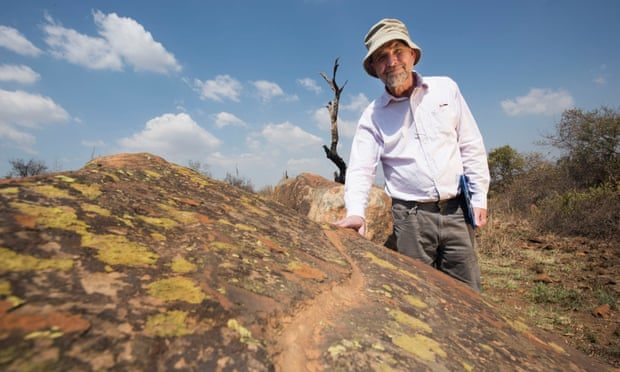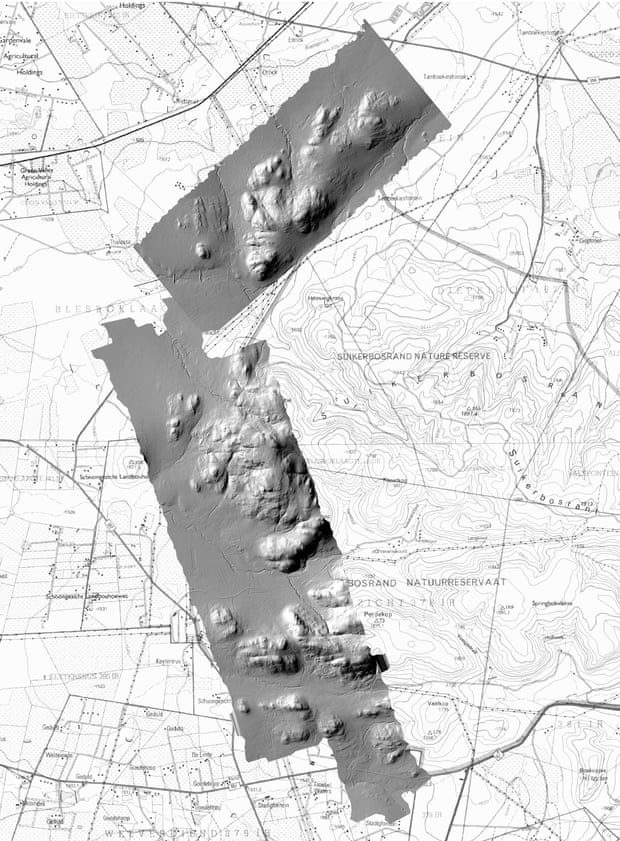
But to Professor Karim Sadr and his team of archaeologists from Johannesburg's University of Witwatersrand, the ruins at Kweneng tell an extraordinary story of a long-lost city.
New laser technology has revealed that Kweneng, about 50km (31 miles) south of South Africa's commercial capital, was once a thriving metropolis with hundreds of households, a vast meeting place, scores of walled family compounds and a bustling market. It was ruled over by kings who regulated trade, waged wars against other similar city states and settled disputes.
The discoveries are important not just for South Africa - which some still claim was largely uninhabited before white settlers colonised the western coast and then pushed inland - but the African continent as a whole.
In recent decades researchers have conclusively shown that western imperialists and historians who dismissed sub-Saharan Africa as a vast wasteland awaiting "civilisation" by Europeans were entirely wrong.
Instead scholars have explored the riches, power and sophistication of cities and civilisations such as Great Zimbabwe, the empire of Mali, the kingdom of Benin and many others. Research has also revealed a continent that was part of global systems of commercial and intellectual exchange from the 15th century - well before the arrival of Europeans.
A recent wave of research has gone further, revealing new layers of complex commercial, agricultural and urban development.
"Now we understand that there was a network of settlements across very large territories and trading connections. These didn't have a single major site and have left limited written or oral traces so have gone under the radar," said Thomas Vernet-Habasque, a Johannesburg-based historian from the Sorbonne who is an expert on the history of pre-colonial Africa.
Kweneng was one of several large settlements across northern parts of what is now South Africa that were inhabited by the Tswana-speaking peoples for many centuries before the first European settlers arrived. Many of these settlements were devastated - but not entirely depopulated - in violent upheavals at the beginning of the 19th century.
The existence of Kweneng has been known for decades, but the new laser technology has revealed its true extent. The laser system works in a similar way to radar detection, except that instead of radio waves, the system sends out laser pulses. A computer then converts the pulses to a high resolution image, from which archaeologists can reconstruct how the area looked in the past.
The city appears to have been split into three main neighbourhoods spread over 20 sq km (8 sq miles), with two very large stone walled enclosures that may have held cattle.
"If all the 900 homesteads of which we've found traces were inhabited at once, then the population could have been up to 20,000, but given references to other cities in the region, it was probably more like 5,000," said Sadr.
There is evidence of considerable sophistication too. "There were four or five levels of local government, probably with regiments organised by age that could be called up for civic work or war. They buried their important dead under the walls of the central cattle enclosures but there was a very strong egalitarian tradition and the king went out of his way to not stand out," Sadr said.
Finding an exact date for the end of Kweneng's days as a major metropolis is very difficult, as current archaeological techniques are not accurate to within decades. But the final days of the city may have been fearful and violent, a victim of the chaotic conflicts known Mfecane, or great scattering, triggered by the military expansion of the Zulu kingdom further south.
A previous dig by a team from Witwatersrand University excavated three homes in the city which appeared to have been deliberately destroyed with fire. Animal bones, weapons and valuable items such as beads had been abandoned, suggesting residents left in a hurry.
"My guess is that the whole city was hit hard. The question is whether it was totally destroyed," said Sadr.
In South Africa, such questions have long had a political dimension. The history of the trading state of Mapungubwe, which was capable of manufacturing magnificent gold objects 800 years ago, was deliberately obscured by racist officials during the apartheid era.
They wanted to hide evidence that the land occupied by white settlers had not only been home to a major African civilisation but also that local populations they dismissed as fit only for manual labour were capable of sophisticated artistic production.
Work at Mapela, once thought to be a small town under the authority of the kings of Mapungubwe, shows the settlement was much bigger than previously thought. Archaeologists have found thousands of glass beads, which suggests that it was a thriving trade centre.
"The trade networks were very complex and intricate. A similarity in copper ingot style suggests that there was trade and exchange between central Africa and southern Africa. Colonial interventions first of all saw the establishment of borders which divided related peoples," said Shadreck Chirikure, an archaeologist at the University of Cape Town, who has excavated parts of Mapela.
The history of land ownership and habitation remains a potent and sensitive issue today.
If Kweneng was still inhabited in the middle of the 18th century, claims by local people to ownership of the land on which the city stood will be strengthened. Demands from local communities to reclaim land that they say is theirs have been blocked in a series of court cases for decades.
The new findings may also begin to change the way visitors to southern Africa understand the environment.
Researchers point out that landscapes seen by tourists as representing the "real Africa" in a pristine "natural" state are nothing of the kind. Communities living in much of South Africa's Kruger national park were forcibly removed when it was established as a nature reserve. Even the famous savannah across much of the continent has been worked by man, with many plants relatively recent introductions by local communities.
"Those environments that we saw as 'wild' are not wild at all," said Vernet-Habasque.




Comment: By allowing archeologists to review vast tracts of land from the comfort of their computer, aerial scanning has revealed a number of discoveries, including unknown monuments and lost civilizations: